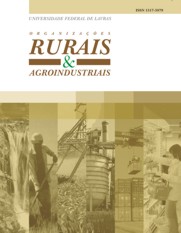Collaborative research network in the milk and dairy sector in Minas Gerais
Keywords:
Collaborative research, networks, sociogram, milk and dairy sectorAbstract
The objective of this study was to describe the structure of the collaborative research network at the dairy sector in Minas Gerais - Brazil. As for the methodology, it is essentially a descriptive research, partly qualitative and partly quantitative. In the quantitative section, two sociograms were developed, based on co-authorships in scientific publications, periodic magazines and event registration, as qualified on the CAPES’ Qualis, for the period between 2003 and 2008. The first sociogram regarded the research network from the milk production sector (farming sector), and the second one was about the research network from the technological and milk-processing sector (post-farming sector). As for the quality section, data were collected through documental research, and twenty personal interviews with researchers and managers connected to dairy-related entities, located in Minas Gerais. Based on the results it was possible to reach the following conclusion: the five most central entities at the milk-producing sector (farming sector) were, in order: Universidade Federal de Viçosa (UFV), Centro Nacional de Pesquisa de Gado de Leite (CNPGL-Embrapa), Empresa Brasileira de Pesquisa Agropecuária (Embrapa), Universidade Estadual Paulista Júlio de Mesquita Filho (UNESP) and Universidade Federal de Minas Gerais (UFMG). While for the technological and milk-processing sector (post-farming sector), the five most central entities were, in order: UFV, Universidade Estadual do Sudoeste da Bahia (UESB), Universidade de São Paulo (USP), UNESP e Instituto de Laticínios Cândido de Tostes (ILCT-Epamig). The overall conclusion is that in the analyzed period, the research network in the dairy products sector exceeded the geographical boundaries of Minas Gerais state and of the Brazil, however, the entities in the state of Minas positioned themselves prominently and ranks among the most central in both sociograms analyzed.


